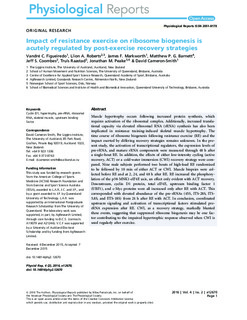| dc.description.abstract | Muscle hypertrophy occurs following increased protein synthesis, which requires activation of the ribosomal complex. Additionally, increased translational capacity via elevated ribosomal RNA (rRNA) synthesis has also been implicated in resistance training-induced skeletal muscle hypertrophy. The time course of ribosome biogenesis following resistance exercise (RE) and the impact exerted by differing recovery strategies remains unknown. In the present study, the activation of transcriptional regulators, the expression levels of pre-rRNA, and mature rRNA components were measured through 48 h after a single-bout RE. In addition, the effects of either low-intensity cycling (active recovery, ACT) or a cold-water immersion (CWI) recovery strategy were compared. Nine male subjects performed two bouts of high-load RE randomized to be followed by 10 min of either ACT or CWI. Muscle biopsies were collected before RE and at 2, 24, and 48 h after RE. RE increased the phosphorylation of the p38-MNK1-eIF4E axis, an effect only evident with ACT recovery. Downstream, cyclin D1 protein, total eIF4E, upstream binding factor 1 (UBF1), and c-Myc proteins were all increased only after RE with ACT. This corresponded with elevated abundance of the pre-rRNAs (45S, ITS-28S, ITS- 5.8S, and ETS-18S) from 24 h after RE with ACT. In conclusion, coordinated
upstream signaling and activation of transcriptional factors stimulated prerRNA expression after RE. CWI, as a recovery strategy, markedly blunted these events, suggesting that suppressed ribosome biogenesis may be one factor contributing to the impaired hypertrophic response observed when CWI is used regularly after exercise. | nb_NO |
